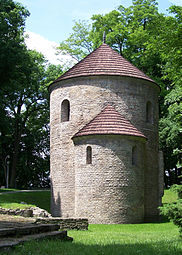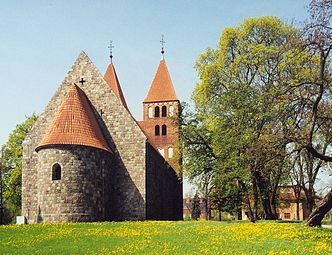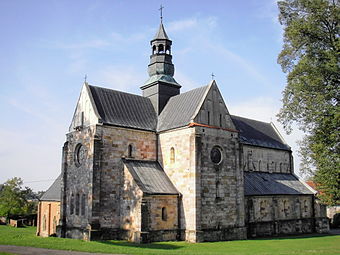
Kuyavian–Pomeranian Voivodeship is one of Poland's 16 voivodeships (provinces).

Magdeburg rights were a set of town privileges first developed by Otto I, Holy Roman Emperor (936–973) and based on the Flemish Law, which regulated the degree of internal autonomy within cities and villages granted by the local ruler. Named after the city of Magdeburg, these town charters were perhaps the most important set of medieval laws in Central Europe. They became the basis for the German town laws developed during many centuries in the Holy Roman Empire. The Magdeburg rights were adopted and adapted by numerous monarchs, including the rulers of Bohemia, Hungary, Poland, and Lithuania, a milestone in the urbanization of the region which prompted the development of thousands of villages and cities.

Świętokrzyskie Voivodeship, also known as Holy Cross Voivodeship, is a voivodeship (province) in southeastern Poland, in the historical region of Lesser Poland. The province's capital and largest city is Kielce.

Lower Silesian Voivodeship in southwestern Poland, is one of the 16 voivodeships (provinces) into which Poland is divided. It covers an area of 19,946 square kilometres (7,701 sq mi), and as of 2019 has a total population of 2,899,986.

Lublin Voivodeship is a voivodeship (province) of Poland, located in the southeastern part of the country, with its capital being the city of Lublin.

Łódź Voivodeship is a voivodeship (province) of Poland. The province is named after its capital and largest city, Łódź, pronounced.

Subcarpathian Voivodeship is a voivodeship, or province, in the southeastern corner of Poland. Its administrative capital and largest city is Rzeszów. Along with the Marshal, it is governed by the Subcarpathian Regional Assembly.

Port Island is an island located between Gdańsk Bay, Śmiała Wisła and Leniwka in northern Poland within the city limits of Gdańsk.

Kulm law, Culm law or Chełmno Law was a legal constitution for a municipal form of government used in several Central European cities in the Middle Ages and early modern period.

Sulejów Abbey is a former Cistercian abbey in Sulejów, Poland, founded in 1176 by Duke Casimir II the Just.

The Abbey church in Czerwińsk nad Wisłą, officially known as the Basilica of the Annunciation of Holy Virgin Mary, is a historic church, built in the 12th century. Despite Gothic and Baroque elements added in later centuries, the basilica remains one of the most valuable examples of Romanesque architecture in Poland, and as such it is listed as a Historic Monument of Poland.

Strzelno is a town in the Kuyavian-Pomeranian Voivodeship, Poland. The town is located 18 km (11.18 mi) south of Inowrocław. According to the June 2005 Census, the population numbered 22,486. It is located in the historic region of Kuyavia. In local baptism records from 1792, the town is spelled as Strzellno.

Czerwińsk nad Wisłą is a town in Płońsk County, Masovian Voivodeship, in central Poland. It is the seat of the gmina called Gmina Czerwińsk nad Wisłą. It lies on the Vistula (Wisła) river, approximately 29 kilometres (18 mi) south of Płońsk and 52 km (32 mi) west of Warsaw. The town has a population of 1,200.
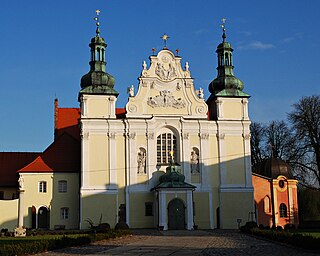
Holy Trinity Church is a Romanesque-Baroque basilica in Strzelno consecrated in 1216. It forms part of the former Norbertine Abbey complex, which is listed as a Historic Monument of Poland.
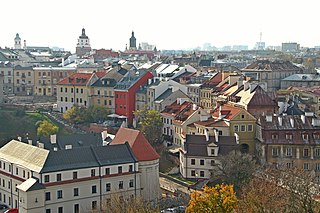
Lublin Old Town is the historic town center of Lublin, Poland, one of the most significant Polish complexes of historic buildings. The Crown Tribunal and the 14th-century Kraków Gate, leading from the Old Town to the city center, are commonly considered symbols of the city.

Radruż is a village in the administrative district of Gmina Horyniec-Zdrój, within Lubaczów County, Subcarpathian Voivodeship, in south-eastern Poland, close to the border with Ukraine. It lies approximately 21 kilometres (13 mi) east of Lubaczów and 101 km (63 mi) east of the regional capital Rzeszów.
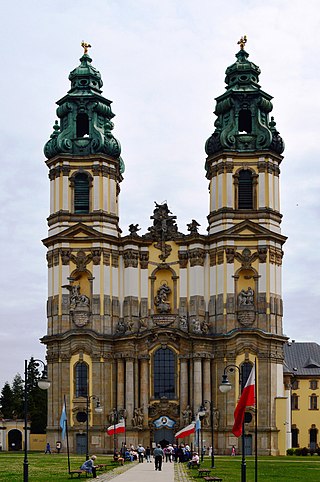
Basilica of the Assumption of the Blessed Virgin Mary in Krzeszów is a Roman Catholic church located within the abbey of the Order of Saint Benedict in Krzeszów, Poland. Built in 1728–1735, it is a notable Baroque church in Lower Silesia and a shrine to the Virgin Mary, listed as a Historic Monument of Poland. It is a basilica since 1998.

Szczecin agglomeration is the urban agglomeration of the city of Szczecin and surrounding towns in the Polish-German border area.

St. Jadwiga's Basilica is a church located in Legnickie Pole, Lower Silesian Voivodeship in Poland. The church hosts the Parish of the Holy Cross and St. Jadwiga and is the central element of the there-founded Monastery of the Order of Saint Benedict.

